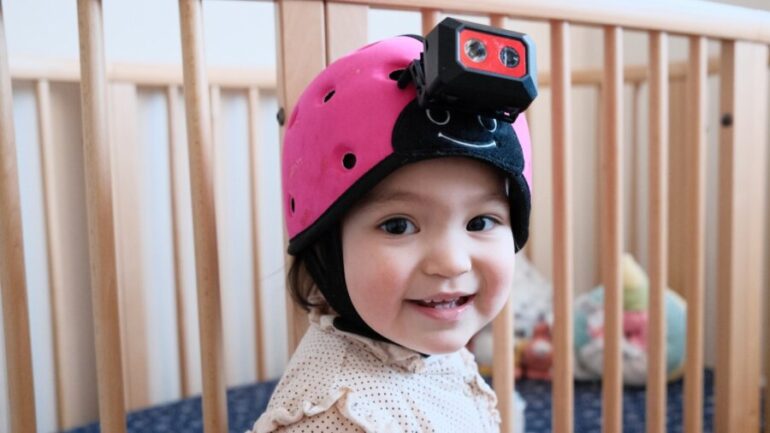TL;DR:
- Researchers used a toddler’s life experiences to train an AI called Child’s View for Contrastive Learning (CVCL) to understand language.
- CVCL closely mimics how children connect sight to audio, in contrast to large language models that rely on massive text datasets.
- The study demonstrated that the AI could link words to their visual counterparts, emulating how children learn language.
- Toddler language acquisition was shown to involve connecting words to what they see, with potential implications for understanding this process.
- The AI performed well in cognitive tests, rivaling models trained on extensive web data and showing the importance of connecting audio with visual inputs.
- The study suggests that combining AI and real-life experiences can revolutionize our understanding of language acquisition and concept formation.
Main AI News:
In a groundbreaking experiment, researchers harnessed the unique perspective of a toddler to teach artificial intelligence (AI) the intricacies of language. This innovative approach has far-reaching implications for understanding the rapid language acquisition and concept development in children.
The study, recently published in Science, centers around a toddler named Sam, who wore a lightweight camera on his forehead from the age of six months. Over the course of a year and a half, Sam’s camera captured fragments of his daily life, from interacting with pets to observing his parents’ culinary endeavors. Crucially, the camera also recorded the sounds he heard, providing a comprehensive sensory input.
The resultant AI model, aptly named Child’s View for Contrastive Learning (CVCL), leverages this wealth of data to emulate a child’s language learning process. Unlike its counterparts, such as ChatGPT and Bard, which rely on vast quantities of text data, CVCL closely mirrors how toddlers connect sight to sound. The study’s lead author, Dr. Wai Keen Vong from NYU’s Center for Data Science, stated, “We show, for the first time, that a neural network trained on this developmentally realistic input from a single child can learn to link words to their visual counterparts.“
Childhood language acquisition is a marvel in itself. At six months, children begin associating words with their visual perceptions – for instance, recognizing a round object as a “ball.” By the age of two, they have already grasped around 300 words and their corresponding concepts. The scientific community has long debated the mechanisms behind this phenomenon, with some theories emphasizing the role of visual matching and others highlighting the need for broader experiences, including social interaction and reasoning.
To unravel these mysteries, the researchers tapped into a unique resource called SAYCam. This repository contains data collected from three toddlers aged between 6 and 32 months, who wore camera-equipped headgear similar to Sam’s. These cameras recorded an hour of video and audio twice a week, creating a treasure trove of multimedia insights into the world from a child’s perspective.
To train the AI, the team devised two neural networks working in tandem, guided by a “judge.” One network translated visual inputs into scene descriptions, while the other extracted words and their meanings from the recorded audio. These two systems were synchronized over time, allowing the AI to associate the correct visuals with words, such as matching a baby’s image to the words “Look, there’s a baby.” With training, it learned to distinguish concepts, like differentiating a yoga ball from a baby.
Despite working with relatively modest amounts of data – around 600,000 video frames and 37,500 transcribed utterances from Sam’s life – the AI performed admirably. In a cognitive test, it correctly identified a ball in an image with a remarkable 62% accuracy, rivaling algorithms trained on vast amounts of web data. The study highlighted the pivotal role of connecting video images with audio in this learning process.
Furthermore, the AI exhibited the ability to generalize to new situations. In one test, it correctly recognized multicolored butterfly images it had never encountered, demonstrating an 80% accuracy rate in identifying the word “butterfly.”
While some word concepts posed challenges – “spoon” is a notable example – the study’s success underscores the potential of combining AI and real-life experiences to mimic childlike learning. Future endeavors may include incorporating video segments to teach verbs and integrating intonation to grasp nuances in speech.
The fusion of AI and life experience heralds a new era in understanding both machine and human cognition. It opens the door to the development of AI models that emulate childlike learning, potentially revolutionizing our comprehension of language acquisition and concept formation in our brains. This experiment marks a significant step towards AI learning language through the eyes and ears of a child.
Conclusion:
This breakthrough in AI language learning, where an AI model emulates a child’s language acquisition process, has significant implications for the market. It signifies a shift towards more efficient and human-like learning algorithms. Businesses in the AI and education sectors should explore the potential for developing AI models that can learn from real-life experiences, potentially revolutionizing language learning and cognitive understanding applications.

